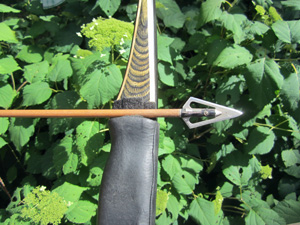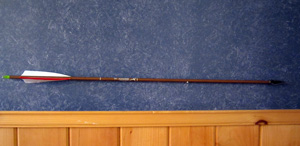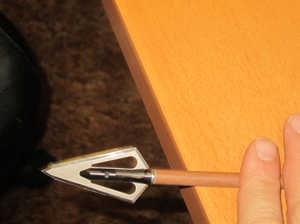
 As much as we hate to admit it, bowhunting is a highly technical sport. The little, finicky things are often what make the difference between success and failure in the field.
As much as we hate to admit it, bowhunting is a highly technical sport. The little, finicky things are often what make the difference between success and failure in the field.
That's why, when it comes to your gear, every detail matters. And, of these, perhaps the most important is shooting a properly tuned broadhead.
A tuned broadhead flies where aimed, does not wind plane and stabilizes quickly in flight. These characteristics contribute to in-field accuracy and better penetration.
A Good Start
Before you begin, put considerable thought and research into broadhead selection. Choose one that's well-constructed with a reputation for sharpness, durability, proper alignment and excellent flight. It should also have a proven record when it comes to penetration and cutting big, lethal holes in game animals. There are plenty that fit the bill.
Pick the weight you want, too, so you can purchase matching field points and arrows and tune your bow for these. That's where you start – with a properly tuned bow and correctly spined arrows and points suitable for the game you are hunting.
Finding the Right Balance
Once you have a tuned bow and have settled on your hunting broadhead, determine your arrow's front-of-center (FOC) percentage. This describes how far forward the balance point of the arrow is beyond the arrow's center. That balance point greatly influences arrow flight.
For hunting arrows, Easton Archery's tuning guide considers a 10 to 15 percent range as acceptable. Some bow hunters prefer even greater FOC percentages, however. That's because arrows with extremely high FOCs stabilize even quicker; this, combined with their typically heavier forward weight, means better penetration. The advantages of an extreme weight forward arrow become even more important on heavily-muscled, big-boned dangerous game.
 To determine FOC percentage, measure total arrow length from the front end of the shaft (excluding the broadhead) to the throat of the nock. Divide that by two and mark it on your arrow. This is the arrow's center point.
To determine FOC percentage, measure total arrow length from the front end of the shaft (excluding the broadhead) to the throat of the nock. Divide that by two and mark it on your arrow. This is the arrow's center point.
Next, with broadhead attached, find the arrow's balance point and mark that, too. Then measure the distance between center and balance point. Finally, divide that measurement by the arrow's total length and multiply by 100. This will give you the FOC percentage.
Here's an example:
An arrow is 28 inches long, thus its center is 14 inches (28 divided by 2). When balanced, the balance point is 3.5 inches forward of center. So 3.5 / 28 X 100 = 12.5 percent. That's the arrow's FOC percentage.
Adjustments
The number above fell within acceptable range, but should you discover that your FOC percentage is too low, all is not lost. Adding weight up front with heavier inserts or brass washers can raise a low FOC percentage. You can also raise the FOC percentage by lightening up the rear of the arrow by switching from plastic vanes to equivalent-sized feathers (which weigh less) or changing to a lighter nock.
If your FOC percentage is too high for your liking, you can increase the size of your arrow's vanes or feathers or add a heavier nock. These add weight to the rear and therefore bring the balance point closer to centre.
If all that fails to get you in your preferred FOC range, you might consider changing broadhead weights. A heavier one will add more weight up front and increase the FOC percentage; a lighter one will decrease it.
Remember, however, when fooling with FOC percentages, too much change can significantly alter your arrow's effective spine, and this could lead to the need to re-tune your bow. That's why it's better from the outset to tune your bow to shoot your hunting arrow and a field point that weighs the same as the broadhead you want to hunt with. Then, the FOC adjustments should be minor.
Take it for a Spin
Another critical step in tuning your broadhead is the spin test. This will determine if the broadhead is aligned. If it isn't, the arrow won't fly straight or consistently; the misaligned broadhead will act as a rudder and steer it off course.
A simple spin test consists of rolling the arrow back and forth off the corner of a desk so that the fletching and broadhead hang off the edges. Look for even the slightest wobble in the broadhead as it spins. If it isn't spinning true, you'll need to fix it.
On aluminum and carbon arrow shafts, wobble is often the result of a misaligned insert. If you suspect that's the case, unscrew the broadhead and try it on another arrow. If it's spinning true in the new arrow, it's probable that the insert of the old arrow isn't set straight.
 A better way of checking alignment is with an arrow spin tester. These handy tools will quickly tell you if your arrow or broadhead isn't spinning true.
A better way of checking alignment is with an arrow spin tester. These handy tools will quickly tell you if your arrow or broadhead isn't spinning true.
Needless to say, if the insert is misaligned, remove and reset it until it is right. If a broadhead on a wooden arrow is misaligned, remove it, heat up the glue and place it on the arrow again until it is mounted straight.
A broadhead can't be tuned if it isn't perfectly aligned.
A Little More Stability
Feather or vanes play also play a critical part in tuning. These, after all, are the rudders that counter the broadhead's tendency to steer the arrow.
A few basic principles apply. Large vanes or feathers stabilize an arrow better than smaller ones. They also cause more drag and add more weight to the rear, thereby lessening FOC percentage, although not always significantly.
As a rule, the closer your FOC percentage is to center the larger the feathers or vanes required to stabilize the arrow. On an extreme forward FOC percentage, you can get away with small fletches. When a FOC percentage is closer to the low end of the accepted range, you probably want larger fletches or vanes to help with in-flight stability.
Whatever vane or feather you settle on, ensure that they are fletched helically or at least offset to get the broadhead spinning – the more spin you can put on the arrow the better the broadhead flight and stability.
The Proof is in the Pudding
As is evident, broadhead tuning is a fairly involved process, especially if your goal is perfect arrow flight – as it should be. Luckily, there are many options in the tuning process and sometimes a combination of minor adjustments is all that's required. Still, it takes time, thought, knowledge and foresight to get this right. But this is certainly achievable if you put in the effort.
Start weeks before hunting season. Then, after tuning, shoot frequently or, better yet, exclusively with a practice broadhead until opening day. This allows you to really study its flight at different ranges, shooting angles and stances so that, by the time hunting season arrives, you can work out any issues that come along and am very confident with their performance. Starting early also gives you time to switch broadheads if you find flaws in the new one.
As always, the proof is in the actual shooting – that's where variables like your shooting style come into play. You need to practice repeatedly at various ranges with the broadhead, making whatever tuning adjustments are required, until you are satisfied with performance.
If possible, set up a video camera to record arrow flight. I have found playing video of arrow flight in slow motion provides valuable insight.
In the end, if you have done your job correctly, your arrows will fly true and your broadhead's impact point will mimic that of your field point's.
It seems like a lot of trouble, but the result is a broadhead the flies true and penetrates to full potential. And that increases the odds of success on any hunt.
- 6299 views

